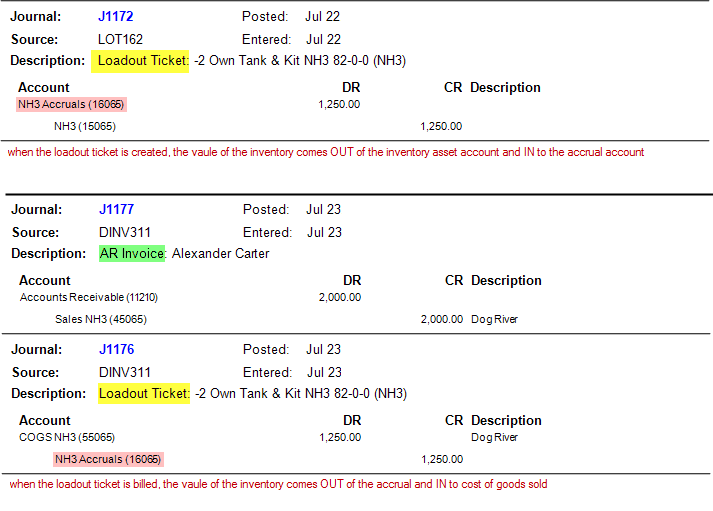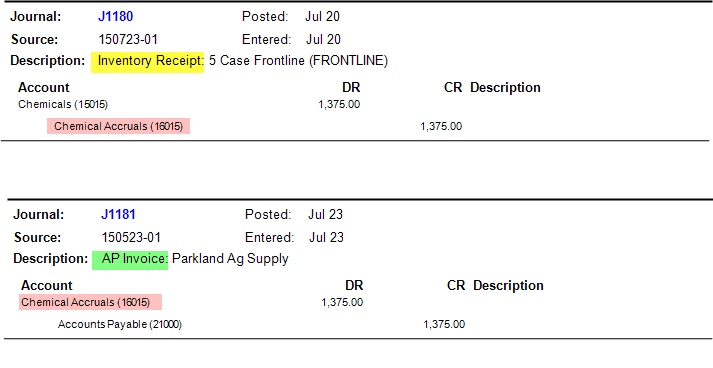FAQs: General Ledger
What you'll find:
General GL
Bank Reconciliation
Fixed Assets
Reports
General Ledger FAQs
General GL
My accountant is asking: how does agrē use inventory accrual accounts?
In agrē, Accrual Accounts are used to hold the value of unbilled inventory.
On the AR side, accrual accounts hold the value of unbilled loadout tickets. When product leaves the yard on a loadout ticket, it's no longer an asset so its value can't be included in the inventory asset account - but it's not billed, so its value can't be included as part of Cost of Good Sold either because the customer doesn't owe for it yet (agrē doesn't consider it "sold" until it's on an invoice). In the interim, its value is posted to an accrual which acts like a "holding account" for unbilled inventory. When the loadout ticket is billed, its value is removed from the accrual account and added to COGS.

Tip
The easiest way to view the postings created by customer activity is from the Customer Account.
On the Account History tab, select the activity (loadout ticket, invoice, payment, etc), click the down-arrow on the View Item button, then select View Posting Details.
On the AP side, Inventory accruals establish liability for the value of inventory physically received before the purchase invoice has arrived from the supplier (technically you don't owe anything until they bill you for it). When an inventory receipt is billed, its value is removed from the accrual account and added to Accounts Payable.

Tip
The easiest way to view the postings created by supplier activity is from the Supplier Account.
On the Account History tab, select the activity (inventory receipt, purchase invoice, payment), click the down-arrow on the View Item button, then select View Posting Details.
Accruals associated with AP Payment Types are used to hold the value of future-dated payments until the payment date comes along.
Normally there is nothing you need to do to an accrual account - just let the balance sort itself out over the course of the year unless your accountant tells you differently.
In a perfect world, if you have no unbilled inventory the balance of inventory accrual accounts should be $0. But if it's not, read on.
Why isn't the balance of my accrual accounts $0 if I have no unbilled inventory?
You have no unbilled Loadout Tickets and no unbilled Inventory Receipts, yet when you run the Accrual Reconciliation report, the balance isn't $0. How can that happen?
1. Direct Postings
The accrual accounts are like any other non-inventory GL accounts in that you can make direct postings to them. If you are seeing "old" postings that have already been corrected, or are from closed fiscal years or periods, run the report with a more recent Starting From date instead of showing all direct postings.
Journal Entries
If you have posted a journal entry to an accrual account in error, delete the existing journal entry, or create a reversing posting and a new correcting journal entry.
Non-Inventory Purchases and Inventory Adjustments
If you have purchased non-inventory items or made inventory adjustments and specifically chosen an accrual account, the postings will go to the specified account. If a posting was made in error, go back and correct the source document.
2. Going Back in Time
Everything may be billed now, but if you are running the report "as of" a date in the past the balance may not be $0.
Delayed Purchase Invoices or Customer Invoices
For example:
inventory is received May 1st, and a posting is made to the inventory asset account and to the inventory accrual account.
the Purchase Invoice isn't received until June 15th, when postings are made to the inventory accrual account and to accounts payable.
From May 1st through June 15th there will be a dollar amount in the inventory accrual account representing the estimated value of the inventory.
Cost Adjustments
Inventory accrual accounts are affected between the date of the inventory received and the date of the purchase invoice that has the cost adjustment on it. The inventory accrual accounts will hold the value of the cost adjustment during this time.
3. Accrual Account doesn't match GL Account Total
This difference could be due to the way the report is run (not showing direct postings for example), or it could be due to rounding.
Rounding causes accrual account balances to fluctuate (being up by a penny today and down by a penny tomorrow). Because of these normal and expected fluctuations, we recommend that you let the system balance itself. At fiscal year-end if you still have a difference of a few pennies, then at that time (after all inventory has been billed for that fiscal year of course) you could make a journal entry to zero out your accrual account using a corresponding expense account (likely COGS). This would start the new fiscal year with a zero balance on the accrual account.
Bank Reconciliation
How do I do my initial bank reconciliation?
Before you dive right in, we suggest reading up on Bank Reconciliations. The overview goes over the general reconciliation process, and will let you know if you need to you enter any Outstanding Bank Transactions before you start reconciling. Then follow along step-by-step with the white paper.
I want to read the Initial Bank Reconciliation white paper (with screen shots).
Fixed Assets
How do I manually dispose of a fixed asset?
Your company has fixed assets, but doesn't use the Fixed Asset module. On January 1, 2017 your company purchased a piece of equipment worth of $2 million. You estimated the salvage value to be $200,000 at the end of its useful life of 5 years. A depreciation expense of ($2,000,000 − $200,000) ÷ 5 or $360,000 is expensed each year.
On December 31, 2021 (the end of its useful life) your company succeeded in selling the asset for $500,000. Since the proceeds of the sale exceed the salvage value by $300,000 the gain is recognized using the following journal entry:
DR: Accumulated Depreciation $1,800,000
DR: Cash $500,000
CR: Equipment $2,000,000
CR: Gain on Disposal $300,000
The equipment account and the related accumulated depreciation account are written off in the process of disposal and the gain is reported in income statement.
In this example the gain is posted into a revenue account, but it could also be an expense account (which in this case you'd post a negative value; if the "gain" had been a loss, you'd post a positive value). Please check with your accountant to see which method they'd prefer you to use.
How can I combine fixed assets?
You have an existing NH3 Tank and want to combine it with the new wagon you just purchased into one fixed asset.
Drop the value of the existing NH3 Tank down to $0 by editing the Tank and adding an Historic Depreciation Item equal to the Book Value. Deactivate the Tank by unchecking the Active box.
Create a new fixed asset for the Wagon and purchase it as a new asset.
Add the value of the NH3 Tank to the Wagon by adding an Historic Purchase Item equal to the Book Value (the same amount you used above).
Should you need to separate the assets in the future (maybe you want to sell the wagon on its own) remove the current Book Value of just the tank (which due to business-as-usual depreciation would likely be less than it was when you combined the assets) from the Wagon, reactivate the old Tank fixed asset, and add it back.